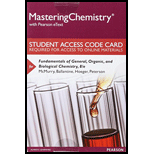
Interpretation:
The given pictures to be predicted as
Concept Introduction:
Atomic radii: The distance between the nucleus and the outermost electron of the atom.
Ionic radii: The distance between the nucleus and the outermost electron of the ion.
Formation of ions:
Atom possesses equal number of protons and electrons and remains electrically neutral. By gaining (accepting electrons) or losing (donating electrons) one or more electrons, converts the neutral atom into a charged particle called IONS.
Cation: The loss of one or more electrons by a neutral atom leaves the atom positively charged called cation.
Anion: The gain of one or more electrons by a neutral atom leaves the neutral atom negatively charged called anion.
The symbolic representation of ions:
The electrons are reside in the principal quantum number ‘n’; by losing and gaining electron, reduces and increases in the electron count in the electronic configuration of the atom; for a cation adding positive charge in superscript to the symbol of the element and for the anion adding negative charge in superscript to the symbol of the element.
Want to see the full answer?
Check out a sample textbook solution
Chapter 3 Solutions
Mastering Chemistry with Pearson eText -- Standalone Access Card -- for Fundamentals of General, Organic, and Biological Chemistry (8th Edition)
- The pH of black coffee is 5, and that of milk of magnesia is 10. Is the coffee twice as acidic as milk of magnesia?arrow_forwardConsider the following acids and their ionization constant, determine which conjugate base is HCOOH Ka = 1.7 x 10-4 (b) HCN Ka = 4.9 x 10-10arrow_forwardAn ion has 15 protons, 16 neutrons, and 18 electrons. The symbol for the ion is 31P3+. 31P3-. 31Ar3+. 34S+. 34S-.arrow_forward
- The pH of a solution containing 20 mL of 0.120 N NaOH and 35 mL of 0.120 N NaOH is 1.49. True or False?arrow_forwardIdentify the acid on the left and its conjugate base on the right in the following equations:(a) HOCl + H2O ↔ H3O+ + OCl-(b) HONH2 + H2O ↔ HONH3+ + OH-(c) NH4+ + H2O ↔ NH3 + H3O+(d) 2HCO3-2 ↔ H2CO3 + CO3-2 (e) PO4-3 + H2PO4- ↔ 2HPO4-2arrow_forwardWhat is the pH of a 0.0032 M solution of NaOH?arrow_forward
- If water were not polar, would it dissolve sodium chloride? Explain.arrow_forwardArrange the elements Na, Si, and S in the order of(a) decreasing atomic radius.(h)increasing first ionization energy.arrow_forwardA compound with empirical formula C2H5O was found in a separate experiment to have a molar mass of approximately 90 g. What is the molecular formula of the compound?arrow_forward
- The molarity of naoh is 0.1715arrow_forwardGive the formulas for the ions in the following two ionic compoundscation (+) anion (-)ammonium chloride _________ _________sodium chloride _________ _________The bromide ion (made from bromine atoms) has the same charge as the chloride ion. Writethe chemical formula for the following two ionic compounds where the bromide ion issubstituted for the chloride ion.ammonium bromide = ________________; sodium bromide =____________________arrow_forwardHow does the atomic structure or composition of the versions of sodium in question C above differ from a typical sodium atom, with its atomic mass of 23?arrow_forward
 Principles Of Radiographic Imaging: An Art And A ...Health & NutritionISBN:9781337711067Author:Richard R. Carlton, Arlene M. Adler, Vesna BalacPublisher:Cengage Learning
Principles Of Radiographic Imaging: An Art And A ...Health & NutritionISBN:9781337711067Author:Richard R. Carlton, Arlene M. Adler, Vesna BalacPublisher:Cengage Learning Human Biology (MindTap Course List)BiologyISBN:9781305112100Author:Cecie Starr, Beverly McMillanPublisher:Cengage Learning
Human Biology (MindTap Course List)BiologyISBN:9781305112100Author:Cecie Starr, Beverly McMillanPublisher:Cengage Learning





